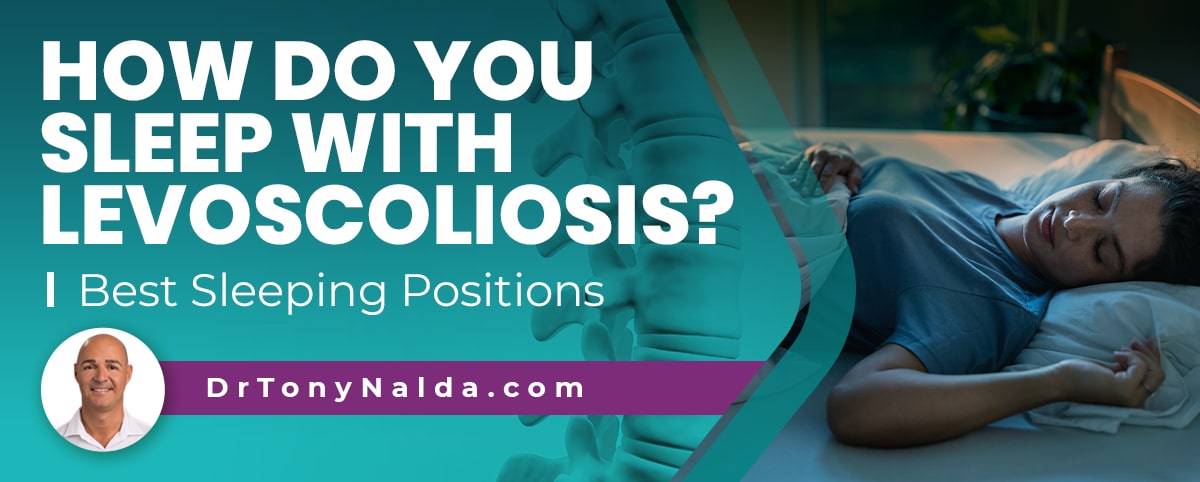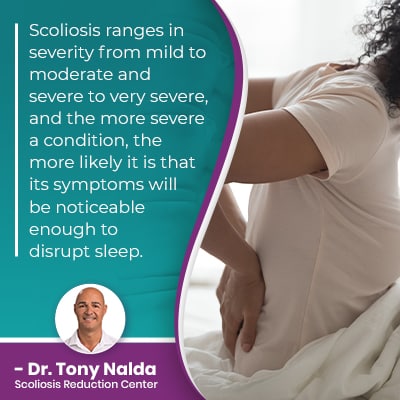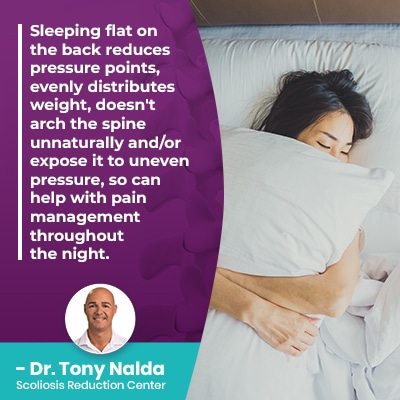How Do You Sleep With Levoscoliosis? Best Sleeping Positions

Not only are there different types of scoliosis a person can develop, there are also multiple curvature types and patterns. Part of diagnosing scoliosis involves comprehensive assessment so conditions can be further classified based on key patient/condition variables, one of which is whether or not the unnatural spinal curve bends to the left (levoscoliosis) or the right (dextroscoliosis).
Levoscoliosis is considered atypical because most scoliotic curves bend to the right, away from the heart, but levoscoliosis curves bends to the left, towards the heart. The best sleeping position for someone with levoscoliosis is sleeping flat on the back.
Before getting to the specifics of healthy sleeping positions for people with levoscoliosis, let's first start with explaining the difference between typical and atypical scoliosis, and this is based on condition type.
Table of Contents
What are the Different Types of Scoliosis?
As mentioned, there are different types of scoliosis, some considered typical, and others considered atypical.
The most prevalent condition type, in both children and adults, is idiopathic, and scoliosis classified as idiopathic means we don't fully understand why it developed; approximately 80 percent of known diagnosed scoliosis cases are idiopathic.
The most common type of idiopathic scoliosis is adolescent idiopathic scoliosis, diagnosed between the ages of 10 and 18, and this age group is at risk for rapid-phase progression.
Regardless of type, something to understand about scoliosis is that as a progressive condition, it has it in its very nature to worsen over time, especially if not treated proactively.
While we don't fully understand the etiology of idiopathic scoliosis, we most certainly know how to treat it, and we do understand what triggers its progression: growth and development.
So idiopathic scoliosis is considered typical, and the remaining 20 percent of known diagnosed scoliosis cases are associated with known causes and are considered atypical: degenerative, neuromuscular, and congenital.
In these atypical cases, a clue that they are atypical is the direction in which the scoliotic curve bends: to the left.
Levoscoliosis vs Dextroscoliosis
So as mentioned, part of the diagnostic process involves comprehensively assessing conditions so they can be further classified; this helps streamline the treatment process and informs the crafting of customized treatment plans.
Classification involves important patient, condition, and curvature details.
In addition to a patient's Cobb angle, which is taken during X-ray and classifies conditions by severity, the direction in which the unnatural spinal curve bends is also important.
In typical cases of scoliosis, the spinal curve will bend to the right, away from the heart, known as dextroscoliosis, but in atypical cases, the curve can bend to the left, towards the heart, known as levoscoliosis.
While some cases of levoscoliosis can be idiopathic, the majority of times, when I see a scoliotic curve bend to the left, this is a red flag for me that there is an underlying pathology that has caused the scoliosis to develop, such as a malformation within the spine itself (congenital scoliosis) or the presence of a larger neuromuscular condition (neuromuscular scoliosis), like muscular dystrophy and cerebral palsy.
So now that we've explored the difference between levoscoliosis and dextroscoliosis, let's talk specifically about the potential challenges of sleeping with scoliosis.
Does Scoliosis Affect Sleep?
Scoliosis is the development of an unnatural sideways spinal curve, with rotation, and if the spine loses one or more of its healthy curves, this causes issues with spinal alignment as the vertebrae (bones of the spine) are no longer aligned in a neutral position.
For scoliosis patients, sleep position and getting a good night's sleep can be even more important than for the average person, and this is due to the challenge of life with scoliosis and the rigors of scoliosis treatment.
Some scoliosis symptoms can make sleep difficult, but I should clearly state that no two cases are the same, which is why the very nature of scoliosis necessitates the customization of effective treatment plans; while some scoliosis patients will experience sleep troubles, it doesn't mean everyone will.
 Scoliosis ranges in severity from mild to moderate and severe to very severe, and the more severe a condition, the more likely it is that its symptoms will be noticeable enough to disrupt sleep.
Scoliosis ranges in severity from mild to moderate and severe to very severe, and the more severe a condition, the more likely it is that its symptoms will be noticeable enough to disrupt sleep.
Scoliosis Symptoms that can Disrupt Sleep
For those experiencing scoliosis pain, this can be a major disruption to sleep.
Being in pain can make it difficult to fall asleep and even harder to find a comfortable sleeping position.
In addition, the uneven forces that scoliosis introduces to the body can cause postural deviation that also makes it difficult to get comfortable, and scoliosis pain doesn't just include localized back pain, but can also include muscle pain and radiating pain throughout the body due to the spinal nerves being compressed.
If left untreated, and particularly in severe cases, scoliosis can also involve lung impairment, which can make it difficult to settle into a regular breathing pattern throughout the night, and chest pain can also be an issue.
So what can a person with levoscoliosis do to get a better sleep?
The Best Sleeping Positions For People With Scoliosis
The best sleeping position for scoliosis is the same as the best sleeping position for people without scoliosis, and this is based on positions that keep the spine in a neutral position while promoting spinal alignment.
I should also take this opportunity to explain that no sleep position can actually change a scoliosis, as in make it better, because as a structural spinal condition, only proactive professional medical advice and treatment can help reduce a scoliosis.
So in addition to ensuring patients have a supportive mattress, a firm mattress, and use supportive pillows, finding a good sleeping position can help with pain relief and getting a good night's rest.
The best sleep position for spinal health is flat on the back.
Back-Sleeping
For people with, and without, scoliosis, sleeping flat on the back is the healthiest sleeping position because it provides extra support for the entire spine, keeps the spine in a straight and neutral position, and can minimize related symptoms.
 Sleeping flat on the back reduces pressure points, evenly distributes weight, doesn't arch the spine unnaturally, and/or expose it to uneven pressure, so can help with pain management throughout the night.
Sleeping flat on the back reduces pressure points, evenly distributes weight, doesn't arch the spine unnaturally, and/or expose it to uneven pressure, so can help with pain management throughout the night.
In addition, combining a quality mattress with a cervical pillow can ensure that the cervical spine is held in alignment with the thoracic and lumbar spinal sections below, while receiving as much support for the neck as possible.
After sleeping flat on the back, the next best sleeping position is side-sleeping.
Side-Sleeping
Side-sleeping is not as ideal as sleeping flat on the back, but it can be done while maintaining spinal alignment and doesn't place the spine at an unnatural angle.
When paired with a thin pillow placed between the knees, the spine is further held in a straight and neutral position, preserving spinal health and alignment.
In addition, a custom pillow can help as the best sleep positions in terms of comfort and pain relief can be affected by body type, which varies from person to person.
Rolled up towels also help between the knees, or under the neck to avoid an unnatural neck twist during sleep.
So now that we've talked about the best positions for sleeping with scoliosis, let's talk about the worst: stomach-sleeping.
The Worst Sleeping Position for Scoliosis: Stomach-Sleeping
So for those with an abnormal curvature of the spine, sleeping flat on the stomach is the worst sleep position in terms of spinal health and alignment.
One of the best sleeping tips is to avoid stomach-sleeping, and this is because it arches the spine unnaturally, can place the cervical spine at an odd angle causing a strenuous neck twist, and also exposes the shoulder blades to uneven pressure and awkward positioning.
When it comes to getting comfortable enough to sleep with an unnatural spinal curvature, the condition's uneven forces can make it difficult, but being mindful of sleep position suggests sleeping flat on the back, then side-sleeping, and that sleeping on your stomach can make scoliosis worse, in terms of pain and the effects of uneven pressure throughout the night.
Also, a traditional mattress is often a spring mattress, rather than memory foam that's known to have good flex, low pressure points, and can affect sleep positively.
The bottom line is when dealing with the added challenge of trying to get comfortable with scoliosis, whatever feels the best is likely to produce the best night's sleep, and part of that can be adding a mattress topper and/or avoiding cushy mattresses, opting instead for a medium firm mattress that provides optimal support.
Conclusion
Scoliosis introduces a lot of uneven forces to the body, and this can cause a wide range of symptoms from pain to postural deviation and lung impairment.
Each case of scoliosis is unique with different severity levels and types, and in addition, scoliotic curves can also vary; a scoliotic curve can either bend to the right, away from the heart (dextroscoliosis), or to the left, towards the heart (levoscoliosis).
When it comes to how to sleep with levoscoliosis, it's about how to find the best sleep position that's not only comfortable, but also doesn't expose the spine to any uneven pressure or arch the spine unnaturally.
The best sleep position for those with, and without, scoliosis is sleeping flat on the back, and this is because it minimizes pressure points, evenly distributes weight throughout the body and spine, and holds the spine in a neutral and aligned position.
Side-sleeping is the next best position, especially when paired with a thin pillow between the knees to keep the spine fully aligned.
The single worst sleep position is sleeping flat on the stomach as this unnaturally arches the cervical and thoracic spine, doesn't hold the spine in alignment, and exposes the spine to uneven pressure, which it's already dealing with.
While there is no sleep position, good or bad, that can actually alter a scoliotic curve structurally, the ability to get restful sleep does increase the likelihood of treatment success by helping to create an environment within the body that's conducive to healing, and is going to be more responsive to treatment.
For those experiencing scoliosis-related sleep problems, the best long-term remedy is proactive treatment that reduces the condition's uneven forces by restoring as much of the spine's natural curves as possible.
Here at the Scoliosis Reduction Center, I believe in treating the whole patient, and this includes addressing any and all scoliosis-related symptoms, including sleep problems.
Dr. Tony Nalda
DOCTOR OF CHIROPRACTIC
After receiving an undergraduate degree in psychology and his Doctorate of Chiropractic from Life University, Dr. Nalda settled in Celebration, Florida and proceeded to build one of Central Florida’s most successful chiropractic clinics.
His experience with patients suffering from scoliosis, and the confusion and frustration they faced, led him to seek a specialty in scoliosis care. In 2006 he completed his Intensive Care Certification from CLEAR Institute, a leading scoliosis educational and certification center.
About Dr. Tony Nalda
 Ready to explore scoliosis treatment? Contact Us Now
Ready to explore scoliosis treatment? Contact Us Now





